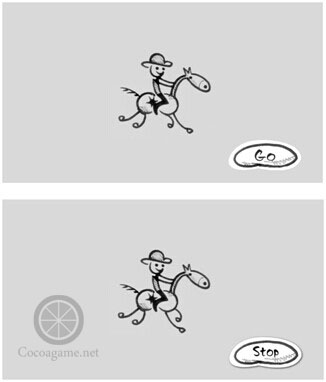Cocos2d-x開發例項介紹幀動畫使用
下面我們通過一個例項介紹一下幀動畫的使用,這個例項如下圖所示,點選Go按鈕開始播放動畫,這時候播放按鈕標題變為Stop,點選Stop按鈕可以停止播放動畫。
下面我們再看看具體的程式程式碼,首先看一下看HelloWorldScene.h檔案,它的程式碼如下:
#ifndef __HELLOWORLD_SCENE_H__ #define __HELLOWORLD_SCENE_H__ #include "cocos2d.h" class HelloWorld : public cocos2d::Layer { bool isPlaying; //播放標識 ① cocos2d::Sprite* sprite; ② public: static cocos2d::Scene* createScene(); virtual bool init(); voidOnAction(cocos2d::Ref* pSender); ③ CREATE_FUNC(HelloWorld); }; #endif // __HELLOWORLD_SCENE_H__
第①行程式碼是宣告一個布林變數isPlaying,用來儲存播放狀態,true時候說明正在播放,false時候說明停止播放。第②行程式碼cocos2d::Sprite*sprite是宣告一個精靈變數。第③行聲明瞭一個函式,用來在選擇不同選單時候的回撥。
HelloWorldScene的實現程式碼HelloWorldScene.ccp檔案,其中HelloWorld::init()函式程式碼如下: bool HelloWorld::init() { if( !Layer::init() ) { returnfalse; } SizevisibleSize = Director::getInstance()->getVisibleSize(); Pointorigin = Director::getInstance()->getVisibleOrigin(); SpriteFrameCache::getInstance()->addSpriteFramesWithFile("run.plist"); autobackground = Sprite::createWithSpriteFrameName("background.png"); background->setAnchorPoint(Point::ZERO); this->addChild(background,0); sprite= Sprite::createWithSpriteFrameName("h1.png"); sprite->setPosition(Point(visibleSize.width/2,visibleSize.height /2)); this->addChild(sprite); isPlaying= false; //toggle選單 autogoSprite = Sprite::createWithSpriteFrameName("go.png"); ① autostopSprite = Sprite::createWithSpriteFrameName("stop.png"); ② autogoToggleMenuItem = MenuItemSprite::create(goSprite, goSprite); ③ auto stopToggleMenuItem = MenuItemSprite::create(stopSprite,stopSprite); ④ auto toggleMenuItem = MenuItemToggle::createWithCallback( CC_CALLBACK_1(HelloWorld::OnAction,this), goToggleMenuItem , stopToggleMenuItem, NULL); ⑤ toggleMenuItem->setPosition(Director::getInstance()->convertToGL(Point(930,540))); ⑥ auto mn = Menu::create(toggleMenuItem, NULL); mn->setPosition(Point::ZERO); this->addChild(mn); returntrue; }
上述程式碼第①行是建立Go按鈕精靈,對應的第③行程式碼是建立Go按鈕(選單項)。程式碼第②行是建立Stop按鈕精靈,對應的第④行程式碼是建立Stop按鈕(選單項)。在第⑤行程式碼是建立Go和Stop是兩種狀態切換的開關選單項。第⑥行程式碼是設定開關選單項的位置。
HelloWorldScene的實現程式碼HelloWorldScene.ccp檔案,其中HelloWorld::OnAction(Ref*pSender)函式程式碼如下:
void HelloWorld::OnAction(Ref* pSender) { if(!isPlaying) { ///////////////動畫開始////////////////////// Animation*animation = Animation::create(); ① for(int i=1; i<= 4; i++) { __String*frameName = __String::createWithFormat("h%d.png",i); ② log("frameName= %s",frameName->getCString()); SpriteFrame*spriteFrame = SpriteFrameCache::getInstance()-> getSpriteFrameByName(frameName->getCString()); ③ animation->addSpriteFrame(spriteFrame); ④ } animation->setDelayPerUnit(0.15f); //設定兩個幀播放時間 ⑤ animation->setRestoreOriginalFrame(true); //動畫執行後還原初始狀態 ⑥ Animate*action = Animate::create(animation); ⑦ sprite->runAction(RepeatForever::create(action)); ⑧ //////////////////動畫結束/////////////////// isPlaying= true; }else { sprite->stopAllActions(); ⑨ isPlaying= false; } }
上述第①行程式碼是建立一個Animation物件,它是動畫物件,然後我們要通過迴圈將各個幀圖片放到Animation物件中。第②行是獲得幀圖片的檔名,String型別是Cocos2d-x字串資料型別。第③行程式碼是通過幀名建立精靈幀物件,第④行程式碼把精靈幀物件新增到Animation物件中。
第⑤行程式碼是animation->setDelayPerUnit(0.15f)是設定兩個幀播放時間,我們這個動畫播放是4幀。第⑥行程式碼animation->setRestoreOriginalFrame(true)是動畫執行完成是否還原到初始狀態。第⑦行程式碼是通過一個Animation物件建立Animate物件,第⑧行程式碼sprite->runAction(RepeatForever::create(action))是執行動畫動作,無限迴圈方式。
第⑨行程式碼sprite->stopAllActions()停止所有的動作。

